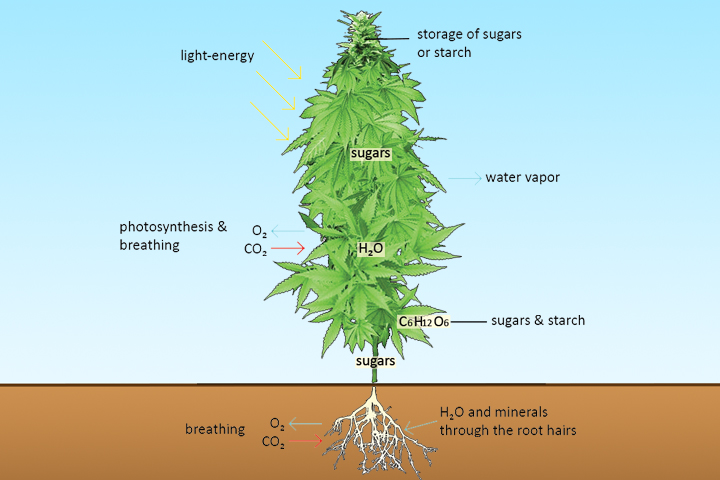
What Is A Marijuana Plant?
Plants play a vital role in our ecosystem- we all depend on their presence. Simply put, we need them for our survival. Even though every plant goes through the photosynthesis process, they are not all created equal. The same goes for cannabis plants.
So, let’s talk about how to recognize cannabis plants and how they operate. If you are planning to grow marijuana it is important that you understand the plant in its entirety.
In this article we will discuss:
Plant development
The root system
Stems: the nutrition highway
The purpose of leaves
Flowers on marijuana plants
Plant development
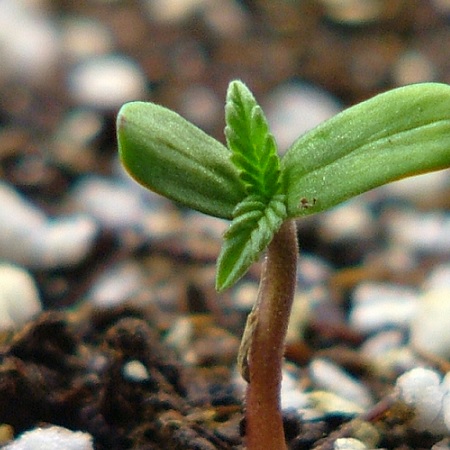
A plant grows through cell elongation and cell division. When the plant cells split in half and make imitations of themselves this is the division process, and elongation occurs as the cells broaden and get larger. Cell division happens on the ends of the roots, the crown, and the border of leaf nodes. You will know that cell division is happening rapidly in those places if you see the plant is growing.
Once new cells are formed during cell division, they will go through cell elongation and take in water from the xylem and get much bigger. If a plant is in good condition and a great growing environment, it has the potential to grow as much as 3 inches per day.
As baby cells grow they can serve many purposes for your plant, which is determined by what the plant needs.
Several varieties of cells can be placed into groups of tissues. Cells can be divided into 3 main segments: vascular, ground, and dermal tissues. Ground cells also known as parenchyma make up the majority of cells inside of plants. This is the useful part of living things. For instance, leaf cells contain mostly parenchymal ground cells, except for the veins and stomata.
The next ones are vascular tissues, which are cell systems that have to carry nutrients and water throughout the plant. The xylem moves minerals and water from the roots to the other parts of the plant, and at the same time phloem transports the output of photosynthesis from the leaves to wherever else it is required to be. For instance, various part of the plant need the energy of the sugars from leaves.
And last but not least there is the dermal tissue, which is the external layer of plant cells. This part serves to protect it from pests, cold and hot temperatures, as well as parasites. The stomata, cell wall, and lustrous external layers make up the dermal tissue. This is what helps the plant to breathe and take in both CO2 and dissolving water.
Root system
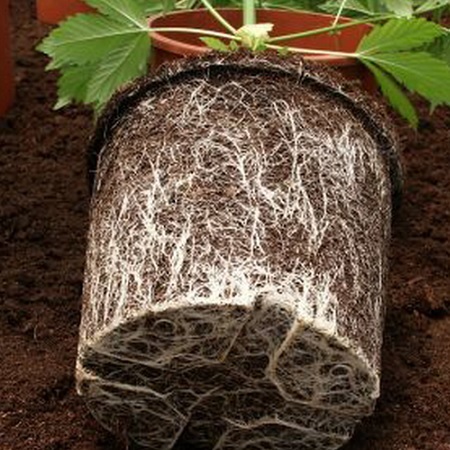
There is so much more to a plant than most people consider. All we usually see is what lies at the surface. The root system can grow so large that it becomes about the size of the actual plant. The roots are how your plant endures dry conditions and also access additional nutrients in the soil.
Your marijuana plant doesn’t require a large root system to grow well. It will do just fine with a small root system. You can grow it in pots or hydroponics, so long as you are willing to put in the necessary work to give it the light, water and nutrients it needs.
Roots tips that are in good condition will be white with little hairs all over it. If you ever notice the roots have turned brown, most likely your plant is in bad shape. At this point, you will need to observe the soil for any signs of root problems. Read the article How to identify root problems for more information.
Evaporation is the foundation for water and nutrient uptake in a plant. Extra water is evaporated through the stomae in the leaves while, below the ground, water presses up against the roots and creates pressure.
The combination of root pressure below and evaporation above create a suction system in the plant that helps promote the flow of nutrients and water from the bottom to the top.
Stems: the nutrition highway

The main structural point of a plant is the stem. The stems are how water and nutrients travel all over the plant. They are the reason your plant can stand up vertically.
The leaves connect to the stem at the node and the other part of the stem is called the internode. How tall a plant gets depends on the amount and how long the internodes are; how many internodes it has remains the same.
Stems have phloem and xylem, which extend downward to the roots. The xylem moves water and minerals from the roots to the newer leaves. Starting inside the leaves, the phloem moves sugar and energy throughout the plant.
It is important for a cannabis plant to have a very strong stems. A broad stem will enhance the movement of energy and make the plant solid so that it does not tumble over as it flourishes.
You can make a solid stem through using air flow. Have a fan blowing on your plant at all times. That way the stimulation causes the plant to broaden the stem while it’s growing. More tips in my free grow bible at this link here
The purpose of leaves
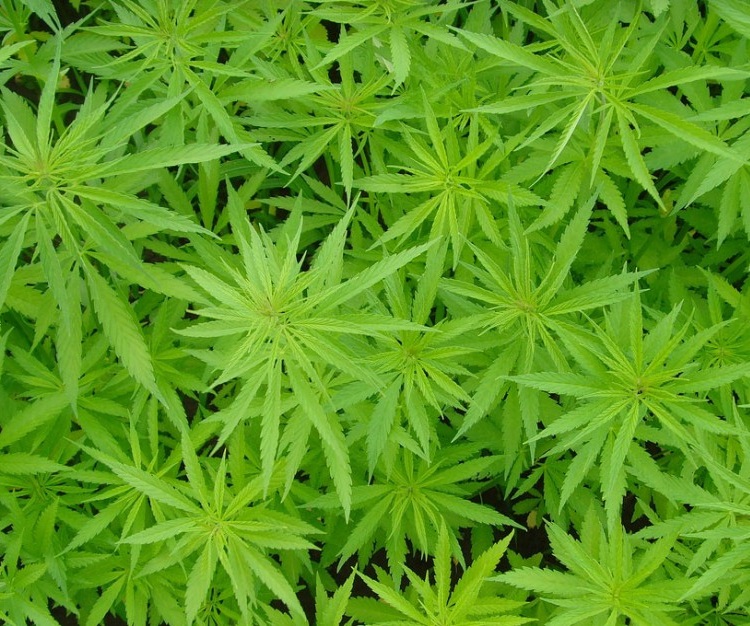
The leaves are the most vital part of any plant because this is where photosynthesis takes place, making it a supplier of food. Plant leaves are made up of petiole (stalk), mesophyll and veins. The mesophyll is the leave’s flesh, and it is here that cells containing chlorophyll catch sunlight, along with CO2 and turn it into energy.
The veins stretch from the leaf tips to the roots, which are made up of phloem and xylem. Xylem moves water and phloem moves energy. You can find the stomata on the bottom half of the leaf. These are the doors to the inside of a plant. They open and close when needed so that oxygen, water vapor, and CO2 can be transported.
Leaves will definitely flourish best in the sun and produces an abundance of chlorophyll. The more chlorophyll a plant has, the more sugar, and since sugar is energy, the plant will be in better condition. Leaves that are in more dim areas will produce less sugar than those in sunlight.
Download my Free marijuana grow bible and learn to grow like a pro!
Nodes can found at the crossroads of leaf bundles. Nodes are a great way to determine how your plant is doing. The first nodes will grow single-fingered leaves, the second will have 3 fingered leaves and the 3rd 5 fingered leaves and it just keeps going on from there.
If the plant is growing in good conditions, it will have more fingers on the leaves, which means a healthy plant. This is important to understand while pruning because plants can have preferences. Make sure you know what and why you are pruning.
Having fans in your grow space to help keep the environment under control because different leaves may be experiencing different temperatures.
Flowers on marijuana plants
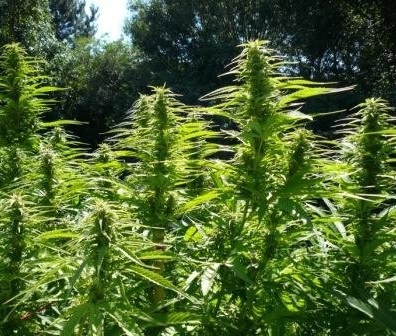
The flowers are the reproductive organs of a Cannabis plant. The flowers are rarely flawless because they are both male and female. The male flowers have stamen, which are a thin tube-like filament topped with pollen covered anther. The females have pistils, with a pillar-like stalk and a stigma at the end. Stigmas are generally sticky in order to catch pollen.
Marijuana plants reproduce through pollination, which occurs through using pollen from the male’s stamen and moving it to the pistil of the female. The flowers also have CBD and THC in them. These are the two main active substances and the reason we want to grow and smoke the plant ;)
You keep these substances at high levels by making sure the female flower never get fertilized. Fertilization causes the female plant to start adding resources to the creation of seeds. If the plant goes without being fertilized it will focus on giving to the creation of calyxes, teardrop nodules that usually have large amounts of trichomes. Those are what secretes THC, as well as other cannabinoids.
Thanks for reading this article. Don't forget to download my free marijuana grow bible and happy growing!
Robert Bergman
www.ilovegrowingmarijuana.com













